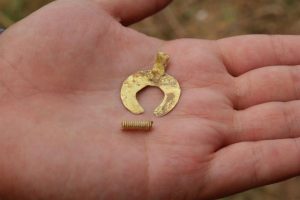Excavations of Polish archaeologists in Metsamor, near Yerevan in Armenia, revealed numerous finds, including a necklace made of gold and cornelian beads. The site is dated to the Early Bronze Age (11th-9th cent. BC).

Archaeologists of the Polish Centre of Mediterranean Archaeology of the University in Warsaw excavated the area of the ancient city and necropolis. At the latter, in a tomb they discovered a burial of a woman with a cracked skull. They discovered golden pendants in shape of a crescent and golden beads, that once formed a necklace. The tomb also contained elements of a horse’s harness and over 1000 cornelian beads. The experts suggest that the burial might be connected with the invasion of Urartian king Argishti I, who conquered the area of Metsomar in 8th century BC.
Other finds include a large, rectangular structure made of stone blocks, that was erected after the fall of the Kingdom of Urartu in 6th century BC, when the area went under Achaemenid king’s reign. The structure is monumental in size, measuring 30 metres in length. It is the largest structure discovered during excavations at the site so far. The archaeologists are unable yet to determine the function of the structure.
(after Nauka w Polsce & Centrum Archeologii Śródziemnomorskiej Uniwersytetu Warszawskiego)